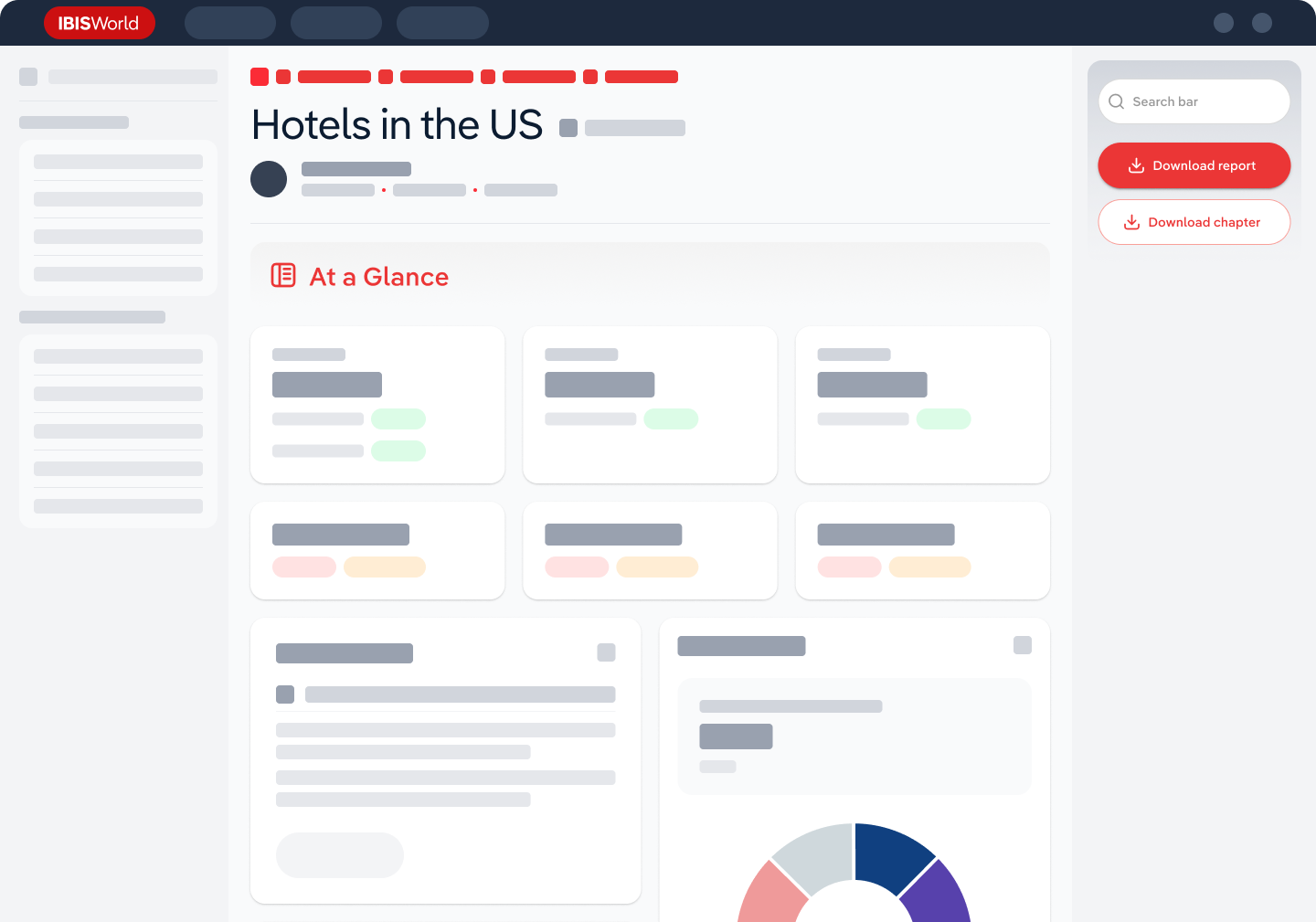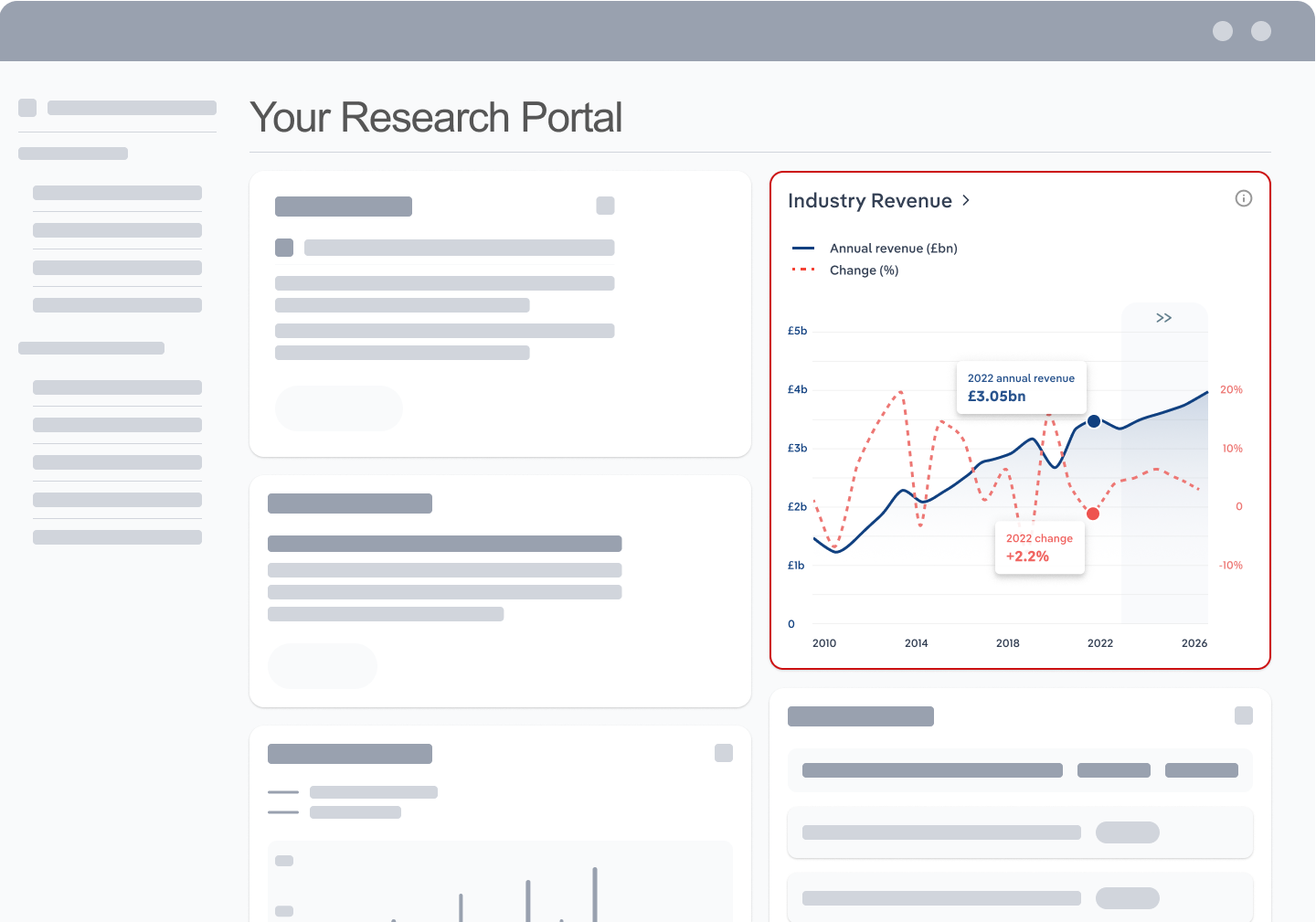Industry Statistics and Trends
Market size and recent performance (2015-2030)
Industry revenue has grown at a CAGR of 4.9 % over the past five years, to reach an estimated €24.5bn in 2025.
Trends and Insights
Recycling is of enormous strategic importance for German copper producers
- Copper has been extracted in various ways for thousands of years. One common method is melting copper ores in a smelting furnace. The ores are first crushed and placed in the furnace, where they are melted at high temperatures. Impurities such as sulphur and iron are removed in order to obtain pure copper. The molten copper is poured into moulds to produce ingots or plates. These can then be further processed by forging, rolling or drawing to achieve the desired shape and size.
- Additional trends and insights available with purchase
Industry outlook (2025-2030)
Market size is projected to grow over the next five years.
Trends and Insights
The switch to electromobility is likely to have a positive impact on industry sales in the coming years
- According to a study conducted by market research company IDTechEx on behalf of the International Copper Association (ICA) in 2020, demand for copper will rise sharply over the next ten years. This is due to the increasing electrification of the automotive sector. Electric vehicles (EVs), which have a copper content almost three times higher than conventional vehicles, are expected to require over 250,000 tonnes of copper per year for electric traction motors by 2030.
Biggest companies in the Copper Production in Germany
| Company | Market Share (%)
2025 | Revenue (€m)
2025 |
|---|---|---|
Aurubis AG | 6,190.0 | |
Wieland-Werke AG | 3,065.1 | |
KME SE | 1,170.1 |
To view the market share and analysis for all 5 top companies in this industry, view purchase options.
Products & Services Segmentation
Industry revenue is measured across several distinct product and services lines, including Plates, sheets and strips, Wire and Bars and profiles. Plates, sheets and strips is the largest segment of the Copper Production in Germany.
Trends and Insights
The proportion of sales generated with sheets, plates and strips is slightly down
- The sheets, plates and strips made of copper and copper alloys in this segment are more than 0.15 millimetres thick. They are mainly used in construction, electrical engineering and mechanical engineering. Products with lower thicknesses are categorised as foils or thin strips.
- More insights available in the full report
Table of Contents
About this industry
Industry definition
This industry is concerned with the production of pure copper from ores, residual materials or scrap. The industry also includes the production of copper alloys such as bronze and brass and initial smelted products such as fused wire and strips, semi-finished copper products and drawn wire made of copper or copper alloys. The industry does not include the casting of copper or copper alloys or the production of insulated wire.
What's included in this industry?
Products and services covered in the Copper Production industry in Germany include Plates, sheets and strips, Wire, Bars and profiles and Tubes.Companies
Companies covered in the Copper Production industry in Germany include Aurubis AG, Wieland-Werke AG and KME SE.Purchase this report to view all 5 major companies in this industry.
Related Terms
Related terms covered in the Copper Production industry in Germany include copper slide, alloying, primary production, forge, rolling and drawing.Industry Code
WZ 24.44 - Copper Production in Germany
Performance
Get an indication of the industry's health through historical, current and forward-looking trends in the performance indicators that make or break businesses.
Analyst insights
The expansion of electromobility is fuelling demand for industry products. Copper is used in numerous components of electric vehicles.
In this chapter (4)
- Current Performance
- Outlook
- Volatility
- Life Cycle
Key metrics
- Annual Revenue, Recent Growth, Forecast, Revenue Volatility
- Number of Employees, Recent Growth, Forecast, Employees per Business, Revenue per Employee
- Number of Businesses, Recent Growth, Forecast, Employees per Business, Revenue per Business
- Total Profit, Profit Margin, Profit per Business
Charts
- Revenue, including historical (2015-2024) and forecast (2025-2030)
- Employees, including historical (2015-2024) and forecast (2025-2030)
- Businesses, including historical (2015-2024) and forecast (2025-2030)
- Profit, including historical (2015-2025)
- Industry Volatility vs. Revenue Growth
- Industry Life Cycle
Detailed analysis
- Trends in supply, demand and current events that are driving current industry performance
- Expected trends, economic factors and ongoing events that drive the industry's outlook
- Key success factors for businesses to overcome volatility
- How contribution to GDP, industry saturation, innovation, consolidation, and technology and systems influence the industry's life cycle phase.
Products and Markets
Learn about an industry's products and services, markets and trends in international trade.
Analyst insight
The advancing digitalisation is leading to increased demand for copper products from the electrical industry. As a result, sales growth is being recorded for wires in particu...
In this chapter
- Products & Services
- Major Markets
- International Trade
Key metrics
- Largest market segment and value in 2025
- Product innovation level
- Total imports, level and trend
- Total exports, level and trend
- Trade Balance
Charts
- Products & services segmentation in 2025
- Major market segmentation in 2025
- International trade, including imports by country and exports by country
Detailed analysis
- Trends impacting the recent performance of the industry's various segments
- Innovations in the industry's product or service offering, specialization or delivery method
- Key factors that successful businesses consider in their offerings
- Buying segments and key trends influencing demand for industry products and services
- Recent trends in import and export volumes, country of origin or destination, and expected future trends
Geographic Breakdown
Discover where business activity is most concentrated in an industry and the factors driving these trends to find opportunities and conduct regional benchmarking.
Analyst insights
North Rhine-Westphalia offers copper producers particularly favourable conditions thanks to its good production and transport infrastructure. The central region also has a la...
In this chapter (1)
- Business Locations
Charts
- Share of revenue, establishment, wages and employment in each region
- Share of population compared to establishments in each region in 2025
Tables
- Number and share of establishments in each region in 2025
- Number and share of revenue each region accounts for in 2025
- Number and share of wages each region accounts for in 2025
- Number and share of employees in each region in 2025
Detailed analysis
- Geographic spread of the industry across Europe, and trends associated with changes in the business landscape
- Key success factors for businesses to use location to their advantage
Competitive Forces
Get data and insights on what's driving competition in an industry and the challenges industry operators and new entrants may face, with analysis built around Porter's Five Forces framework.
Analyst insights
The industry is dominated by two suppliers. The market leaders Aurubis and Wieland benefit from long-standing relationships with customers and suppliers and can manufacture t...
In this chapter (4)
- Concentration
- Barriers to Entry
- Substitutes
- Buyer & Supplier Analysis
Key metrics
- Industry concentration level
- Industry competition level and trend
- Barriers to entry level and trend
- Substitutes level and trend
- Buyer power level and trend
- Supplier power level and trend
Charts
- Market share concentration among the top 4 suppliers from 2020-2025
- Supply chain including upstream supplying industries and downstream buying industries, flow chart
Detailed analysis
- Factors impacting the industry’s level of concentration, such as business distribution, new entrants, or merger and acquisition activity.
- Key success factors for businesses to manage the competitive environment of the industry.
- Challenges that potential industry entrants face such as legal, start-up costs, differentiation, labor/capital intensity and capital expenses.
- Key success factors for potential entrants to overcome barriers to entry.
- Competitive threats from potential substitutes for the industry’s own products and services.
- Key success factors for how successful businesses can compete with substitutes.
- Advantages that buyers have to keep favorable purchasing conditions.
- Advantages that suppliers have to maintain favorable selling conditions.
- Key success factors for how businesses can navigate buyer and supplier power.
Companies
Learn about the performance of the top companies in the industry.
Analyst insights
The market leader Aurubis is characterised by its extensive recycling activities. This enables the company to reduce the use of primary raw materials such as copper ore and l...
In this chapter
- Market Share Concentration
- Companies
- Company Spotlights
Charts
- Industry market share by company in 2021 through 2025
- Major companies in the industry, including market share, revenue, profit and profit margin in 2025
- Overview of Aurubis AG's performance by revenue, market share and profit margin from 2019 through 2025
- Overview of Wieland-Werke AG's performance by revenue, market share and profit margin from 2019 through 2025
- Overview of KME SE's performance by revenue, market share and profit margin from 2019 through 2025
- Overview of revenue, market share and profit margin trend for 2 additional companies
Detailed analysis
- Description and key data for Aurubis AG, and factors influencing its performance in the industry
- Description and key data for Wieland-Werke AG, and factors influencing its performance in the industry
- Description and key data for KME SE, and factors influencing its performance in the industry
- Description, key data and performance trends for 2 additional companies
External Environment
Understand the demographic, economic and regulatory factors that shape how businesses in an industry perform.
Analyst insights
The industry is heavily regulated in terms of environmental protection and occupational health and safety. For example, CO2 emissions are to be reduced and companies must com...
In this chapter
- External Drivers
- Regulation & Policy
- Assistance
Key metrics
- Regulation & policy level and trend
- Assistance level and trend
Charts
- Regulation & Policy historical data and forecast (2015-2030)
- Assistance historical data and forecast (2015-2030)
Detailed analysis
- Demographic and macroeconomic factors influencing the industry, including Regulation & Policy and Assistance
- Major types of regulations, regulatory bodies, industry standards or specific regulations impacting requirements for industry operators
- Key governmental and non-governmental groups or policies that may provide some relief for industry operators.
Financial Benchmarks
View average costs for industry operators and compare financial data against an industry's financial benchmarks over time.
Analyst insights
The cost of materials is by far the largest cost factor. This is due to the high prices for copper that industry players have to pay for input factors such as ores, scrap, bu...
In this chapter
- Cost Structure
- Financial Ratios
- Key Ratios
Key metrics
- Profit margin, and how it compares to the sector-wide margin
- Average wages, and how it compares to the sector-wide average wage
- Largest cost component as a percentage of revenue
- Industry average ratios for days' receivables, industry coverage and debt-to-net-worth ratio
Charts
- Average industry operating costs as a share of revenue, including purchases, wages, depreciation, utilities, rent, other costs and profit in 2025
- Average sector operating costs as a share of revenue, including purchases, wages, depreciation, utilities, rent, other costs and profit in 2025
- Investment vs. share of economy
Data tables
- Cash Flow & Debt Service Ratios (2015-2030)
- Revenue per Employee (2015-2030)
- Revenue per Enterprise (2015-2030)
- Employees per Establishment (2015-2030)
- Employees per Enterprise (2015-2030)
- Average Wage (2015-2030)
- Wages/Revenue (2015-2030)
- Establishments per Enterprise (2015-2030)
- IVA/Revenue (2015-2030)
- Imports/Demand (2015-2030)
- Exports/Revenue (2015-2030)
Detailed analysis
- Trends in the cost component for industry operators and their impact on industry costs and profitability
Key Statistics
Industry Data
Data Tables
Including values and annual change:
- Revenue (2015-2030)
- IVA (2015-2030)
- Establishments (2015-2030)
- Enterprises (2015-2030)
- Employment (2015-2030)
- Exports (2015-2030)
- Imports (2015-2030)
- Wages (2015-2030)
Top Questions Answered
Unlock comprehensive answers and precise data upon purchase. View purchase options.
What is the market size of the Copper Production industry in Germany in 2025?
The market size of the Copper Production industry in Germany is €24.5bn in 2025.
How many businesses are there in the Copper Production industry in Germany in 2025?
There are 42 businesses in the Copper Production industry in Germany, which has grown at a CAGR of 0.5 % between 2020 and 2025.
How may import tariffs affect the Copper Production industry in Germany?
The Copper Production industry in Germany is likely to be significantly impacted by import tariffs with imports accounting for a high share of industry revenue.
How may export tariffs affect the Copper Production industry in Germany?
The Copper Production industry in Germany is likely to be significantly impacted by export tariffs with exports accounting for a high share of industry revenue.
Has the Copper Production industry in Germany grown or declined over the past 5 years?
The market size of the Copper Production industry in Germany has been growing at a CAGR of 4.9 % between 2020 and 2025.
What is the forecast growth of the Copper Production industry in Germany over the next 5 years?
Over the next five years, the Copper Production industry in Germany is expected to grow.
What are the biggest companies in the Copper Production industry in Germany?
The biggest companies operating in the Copper Production industry in Germany are Aurubis AG, Wieland-Werke AG and KME SE
What does the Copper Production industry in Germany include?
Plates, sheets and strips and Wire are part of the Copper Production industry in Germany.
Which companies have the highest market share in the Copper Production industry in Germany?
The company holding the most market share in the Copper Production industry in Germany is Aurubis AG.
How competitive is the Copper Production industry in Germany?
The level of competition is moderate and steady in the Copper Production industry in Germany.
Methodology
How are IBISWorld reports created?
IBISWorld has been a leading provider of trusted industry research for over 50 years to the most successful companies worldwide. With offices in Australia, the United States, the United Kingdom, Germany and China, we are proud to have local teams of analysts that conduct research, data analysis and forecasting to produce data-driven industry reports.
Our analysts start with official, verified and publicly available sources of data to build the most accurate picture of each industry. Analysts then leverage their expertise and knowledge of the local markets to synthesize trends into digestible content for IBISWorld readers. Finally, each report is reviewed by one of IBISWorld’s editors, who provide quality assurance to ensure accuracy and readability.
IBISWorld relies on human-verified data and human-written analysis to compile each standard industry report. We do not use generative AI tools to write insights, although members can choose to leverage AI-based tools within the platform to generate additional analysis formats.
What data sources do IBISWorld analysts use?
Each industry report incorporates data and research from government databases, industry-specific sources, industry contacts, and our own proprietary database of statistics and analysis to provide balanced, independent and accurate insights.
Key data sources in Germany include:
- German Federal Statistics Office (Destatis)
- European Statistics Office (Eurostat)
- United Nations Comtrade
Analysts also use industry specific sources to complement catch-all sources, although their perspective may focus on a particular organization or representative body, rather than a clear overview of all industry operations. However, when balanced against other perspectives, industry-specific sources provide insights into industry trends.
These sources include:
- Industry and trade associations
- Industry federations or regulators
- Major industry players annual or quarterly filings
Finally, IBISWorld’s global data scientists maintain a proprietary database of macroeconomic and demand drivers, which our analysts use to help inform industry data and trends. They also maintain a database of statistics and analysis on thousands of industries, which has been built over our more than 50-year history and offers comprehensive insights into long-term trends.
How does IBISWorld forecast its data?
IBISWorld’s analysts and data scientists use the sources above to create forecasts for our proprietary datasets and industry statistics. Depending on the dataset, they may use regression analysis, multivariate analysis, time-series analysis or exponential smoothing techniques to project future data for the industry or driver. Additionally, analysts will leverage their local knowledge of industry operating and regulatory conditions to impart their best judgment on the forecast model.
IBISWorld prides itself on being a trusted, independent source of data, with over 50 years of experience building and maintaining rich datasets and forecasting tools. We are proud to be the keystone source of industry information for thousands of companies across the world.
Learn more about our methodology and data sourcing on the Help Center.










